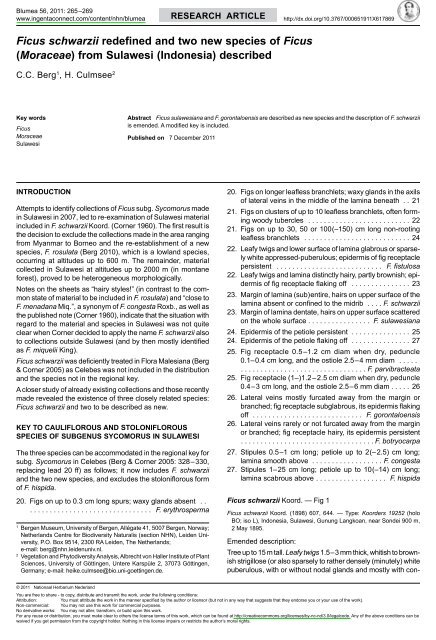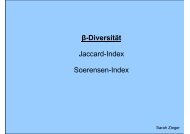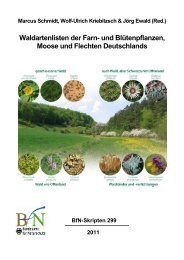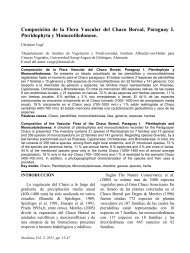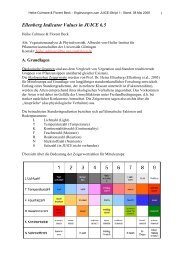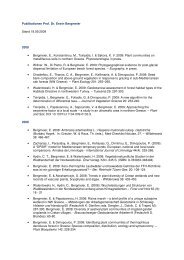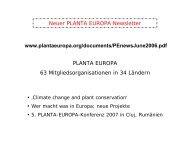Ficus schwarzii redefined and two new species of Ficus (Moraceae ...
Ficus schwarzii redefined and two new species of Ficus (Moraceae ...
Ficus schwarzii redefined and two new species of Ficus (Moraceae ...
You also want an ePaper? Increase the reach of your titles
YUMPU automatically turns print PDFs into web optimized ePapers that Google loves.
Blumea 56, 2011: 265–269<br />
www.ingentaconnect.com/content/nhn/blumea<br />
RESEARCH ARTICLE<br />
http://dx.doi.org/10.3767/000651911X617869<br />
<strong>Ficus</strong> <strong>schwarzii</strong> <strong>redefined</strong> <strong>and</strong> <strong>two</strong> <strong>new</strong> <strong>species</strong> <strong>of</strong> <strong>Ficus</strong><br />
(<strong>Moraceae</strong>) from Sulawesi (Indonesia) described<br />
C.C. Berg 1 , H. Culmsee 2<br />
Key words<br />
<strong>Ficus</strong><br />
<strong>Moraceae</strong><br />
Sulawesi<br />
Abstract <strong>Ficus</strong> sulawesiana <strong>and</strong> F. gorontaloensis are described as <strong>new</strong> <strong>species</strong> <strong>and</strong> the description <strong>of</strong> F. <strong>schwarzii</strong><br />
is emended. A modified key is included.<br />
Published on 7 December 2011<br />
INTRODUCTION<br />
Attempts to identify collections <strong>of</strong> <strong>Ficus</strong> subg. Sycomorus made<br />
in Sulawesi in 2007, led to re-examination <strong>of</strong> Sulawesi material<br />
included in F. <strong>schwarzii</strong> Koord. (Corner 1960). The first result is<br />
the decision to exclude the collections made in the area ranging<br />
from Myanmar to Borneo <strong>and</strong> the re-establishment <strong>of</strong> a <strong>new</strong><br />
<strong>species</strong>, F. rosulata (Berg 2010), which is a lowl<strong>and</strong> <strong>species</strong>,<br />
occurring at altitudes up to 600 m. The remainder, material<br />
collected in Sulawesi at altitudes up to 2000 m (in montane<br />
forest), proved to be heterogeneous morphologically.<br />
Notes on the sheets as “hairy styles!” (in contrast to the common<br />
state <strong>of</strong> material to be included in F. rosulata) <strong>and</strong> “close to<br />
F. menadana Miq.”, a synonym <strong>of</strong> F. congesta Roxb., as well as<br />
the published note (Corner 1960), indicate that the situation with<br />
regard to the material <strong>and</strong> <strong>species</strong> in Sulawesi was not quite<br />
clear when Corner decided to apply the name F. <strong>schwarzii</strong> also<br />
to collections outside Sulawesi (<strong>and</strong> by then mostly identified<br />
as F. miquelii King).<br />
<strong>Ficus</strong> <strong>schwarzii</strong> was deficiently treated in Flora Malesiana (Berg<br />
& Corner 2005) as Celebes was not included in the distribution<br />
<strong>and</strong> the <strong>species</strong> not in the regional key.<br />
A closer study <strong>of</strong> already existing collections <strong>and</strong> those recently<br />
made revealed the existence <strong>of</strong> three closely related <strong>species</strong>:<br />
<strong>Ficus</strong> <strong>schwarzii</strong> <strong>and</strong> <strong>two</strong> to be described as <strong>new</strong>.<br />
KEY TO CAULIFLOROUS AND STOLONIFLOROUS<br />
SPECIES OF SUBGenus SYCOMORUS IN SULAWESI<br />
The three <strong>species</strong> can be accommodated in the regional key for<br />
subg. Sycomorus in Celebes (Berg & Corner 2005: 328–330,<br />
replacing lead 20 ff) as follows; it now includes F. <strong>schwarzii</strong><br />
<strong>and</strong> the <strong>two</strong> <strong>new</strong> <strong>species</strong>, <strong>and</strong> excludes the stoloniflorous form<br />
<strong>of</strong> F. hispida.<br />
20. Figs on up to 0.3 cm long spurs; waxy gl<strong>and</strong>s absent . .<br />
. . . . . . . . . . . . . . . . . . . . . . . . . . . . . . . F. erythrosperma<br />
1<br />
Bergen Museum, University <strong>of</strong> Bergen, Allégate 41, 5007 Bergen, Norway;<br />
Netherl<strong>and</strong>s Centre for Biodiversity Naturalis (section NHN), Leiden University,<br />
P.O. Box 9514, 2300 RA Leiden, The Netherl<strong>and</strong>s;<br />
e-mail: berg@nhn.leidenuniv.nl.<br />
2<br />
Vegetation <strong>and</strong> Phytodiversity Analysis, Albrecht von Haller Institute <strong>of</strong> Plant<br />
Sciences, University <strong>of</strong> Göttingen, Untere Karspüle 2, 37073 Göttingen,<br />
Germany; e-mail: heike.culmsee@bio.uni-goettingen.de.<br />
20. Figs on longer leafless branchlets; waxy gl<strong>and</strong>s in the axils<br />
<strong>of</strong> lateral veins in the middle <strong>of</strong> the lamina beneath . . 21<br />
21. Figs on clusters <strong>of</strong> up to 10 leafless branchlets, <strong>of</strong>ten forming<br />
woody tubercles . . . . . . . . . . . . . . . . . . . . . . . . . . 22<br />
21. Figs on up to 30, 50 or 100(–150) cm long non-rooting<br />
leafless branchlets . . . . . . . . . . . . . . . . . . . . . . . . . . . 24<br />
22. Leafy twigs <strong>and</strong> lower surface <strong>of</strong> lamina glabrous or sparsely<br />
white appressed-puberulous; epidermis <strong>of</strong> fig receptacle<br />
persistent . . . . . . . . . . . . . . . . . . . . . . . . . . . F. fistulosa<br />
22. Leafy twigs <strong>and</strong> lamina distinctly hairy, partly brownish; epidermis<br />
<strong>of</strong> fig receptacle flaking <strong>of</strong>f . . . . . . . . . . . . . . . 23<br />
23. Margin <strong>of</strong> lamina (sub)entire, hairs on upper surface <strong>of</strong> the<br />
lamina absent or confined to the midrib . . . . F. <strong>schwarzii</strong><br />
23. Margin <strong>of</strong> lamina dentate, hairs on upper surface scattered<br />
on the whole surface . . . . . . . . . . . . . . . . F. sulawesiana<br />
24. Epidermis <strong>of</strong> the petiole persistent . . . . . . . . . . . . . . . 25<br />
24. Epidermis <strong>of</strong> the petiole flaking <strong>of</strong>f . . . . . . . . . . . . . . . 27<br />
25. Fig receptacle 0.5 –1.2 cm diam when dry, peduncle<br />
0.1–0.4 cm long, <strong>and</strong> the ostiole 2.5–4 mm diam . . . . .<br />
. . . . . . . . . . . . . . . . . . . . . . . . . . . . . . . . F. parvibracteata<br />
25. Fig receptacle (1–)1.2–2.5 cm diam when dry, peduncle<br />
0.4–3 cm long, <strong>and</strong> the ostiole 2.5–6 mm diam . . . . . 26<br />
26. Lateral veins mostly furcated away from the margin or<br />
branched; fig receptacle subglabrous, its epidermis flaking<br />
<strong>of</strong>f . . . . . . . . . . . . . . . . . . . . . . . . . . . . F. gorontaloensis<br />
26. Lateral veins rarely or not furcated away from the margin<br />
or branched; fig receptacle hairy, its epidermis persistent<br />
. . . . . . . . . . . . . . . . . . . . . . . . . . . . . . . . . . F. botryocarpa<br />
27. Stipules 0.5–1 cm long; petiole up to 2(–2.5) cm long;<br />
lamina smooth above . . . . . . . . . . . . . . . . . . F. congesta<br />
27. Stipules 1–25 cm long; petiole up to 10(–14) cm long;<br />
lamina scabrous above . . . . . . . . . . . . . . . . . . F. hispida<br />
<strong>Ficus</strong> <strong>schwarzii</strong> Koord. — Fig 1<br />
<strong>Ficus</strong> <strong>schwarzii</strong> Koord. (1898) 607, 644. — Type: Koorders 19252 (holo<br />
BO; iso L), Indonesia, Sulawesi, Gunung Langkoan, near Sondei 900 m,<br />
2 May 1895.<br />
Emended description:<br />
Tree up to 15 m tall. Leafy twigs 1.5–3 mm thick, whitish to brownish<br />
strigillose (or also sparsely to rather densely (minutely) white<br />
puberulous, with or without nodal gl<strong>and</strong>s <strong>and</strong> mostly with con-<br />
© 2011 Nationaal Herbarium Nederl<strong>and</strong><br />
You are free to share - to copy, distribute <strong>and</strong> transmit the work, under the following conditions:<br />
Attribution:<br />
You must attribute the work in the manner specified by the author or licensor (but not in any way that suggests that they endorse you or your use <strong>of</strong> the work).<br />
Non-commercial: You may not use this work for commercial purposes.<br />
No derivative works: You may not alter, transform, or build upon this work.<br />
For any reuse or distribution, you must make clear to others the license terms <strong>of</strong> this work, which can be found at http://creativecommons.org/licenses/by-nc-nd/3.0/legalcode. Any <strong>of</strong> the above conditions can be<br />
waived if you get permission from the copyright holder. Nothing in this license impairs or restricts the author’s moral rights.
266 Blumea – Volume 56 / 3, 2011<br />
5 cm<br />
b<br />
1 cm<br />
1 mm<br />
c<br />
d<br />
Fig. 1 <strong>Ficus</strong> <strong>schwarzii</strong> Koord. a. Leafy twig; b. branched fig-bearing branchlet with cluster <strong>of</strong> figs; c. fig receptacle in longitudinal section; d. long-styled pistillate<br />
flowers; e. staminate flower (a–d: Culmsee 3165; e: S<strong>and</strong>s 401).<br />
e<br />
a<br />
spicuous (warty) lenticels below the (scars <strong>of</strong> the) stipules, with<br />
small abortive axillary buds, the scars <strong>of</strong> the leaves prominent;<br />
internodes hollow or solid; periderm persistent or flaking <strong>of</strong>f.<br />
Leaves laxly spirally arranged to subdistichous to partly subopposite;<br />
lamina oblong to elliptic or to (sub)obovate, 3–15(–18)<br />
by (1–)2–5(–7) cm, (almost) symmetric, chartaceous to subcoriaceous,<br />
apex acuminate to subcaudate (or to obtuse), base<br />
equilateral to slightly inequilateral, cuneate to rounded, margin<br />
(sub)entire; upper surface sparsely whitish to brownish strigillose,<br />
mainly on the midrib (or glabrous), smooth, lower surface<br />
sparsely brownish to whitish strigillose on the main veins,<br />
smooth, cystoliths only beneath; lateral veins (4–)6–10 pairs,<br />
none <strong>of</strong> them furcate away from the margin, tertiary venation<br />
reticulate or towards the margin (sub)scalariform; waxy gl<strong>and</strong>s<br />
in the axils <strong>of</strong> some <strong>of</strong> the lateral veins in the middle part <strong>of</strong><br />
the lamina; petiole 0.3–1.5(–3.5) cm long, sparsely brownish<br />
to whitish strigillose, the epidermis flaking <strong>of</strong>f; stipules 0.5–1.8<br />
cm long, subglabrous or strigillose mainly on the keel, caducous<br />
or (sub)persistent (when juvenile). Figs on (the lower part <strong>of</strong>)<br />
the trunk, in (clusters <strong>of</strong>) up to 8 cm long, branched leafless<br />
branchlets with terminally c. 3 mm long scale-like persistent<br />
stipules; peduncle 0.4–1.2 cm long, minutely puberulous; basal<br />
bracts 3, verticillate, 2–3 mm long; receptacle subglobose to<br />
depressed-globose, 1–1.5(–1.8) cm diam when dry, minutely<br />
puberulous to glabrous, non-stipitate, ribbed, without lateral<br />
bracts, with (warty) lenticels <strong>and</strong> the epidermis flaking <strong>of</strong>f, pinkish<br />
to brick-red to red-brown, turning (finally) black at maturity,<br />
apex slightly convex to flat to concave, ostiole 3–4 mm diam,<br />
with the upper ostiolar bracts horizontal, surrounded by 4–5<br />
short erect to inflexed apical bracts; internal hairs sparse <strong>and</strong><br />
brown or absent. Staminate flower with one stamen. Style <strong>of</strong><br />
the long-styled flower glabrous or minutely hairy, the stigma<br />
<strong>of</strong>ten distinctly papillate.<br />
Distribution — Indonesia, Southern <strong>and</strong> Central Sulawesi.<br />
Habitat — Forest at altitudes up to 1900 m.<br />
Additional collections from Indonesia, Sulawesi. G. Brown et al. 9 (L),<br />
Latimojon Ranges, Lombasang, 950 m; Culmsee 744 (GOET), 759 (L), 855<br />
(GOET, L), 933 (L) <strong>and</strong> 984 (L), Lore-Lindu National Park, Pono valley, Toro,
C.C. Berg & H. Culmsee: <strong>Ficus</strong> <strong>schwarzii</strong> <strong>redefined</strong> <strong>and</strong> <strong>two</strong> <strong>new</strong> <strong>Ficus</strong> <strong>species</strong><br />
267<br />
1 mm<br />
c<br />
b<br />
1 cm<br />
b<br />
5 cm<br />
d<br />
1 mm<br />
a<br />
Fig. 2 <strong>Ficus</strong> sulawesiana C.C.Berg & Culmsee. a. Leafy twig; b. upper surface <strong>of</strong> lamina; c. figs, closed <strong>and</strong> in longitudinal section; d. long-styled pistillate<br />
flowers (a, b: Culmsee 3037; c, d: Bünnemeyer 12056).<br />
1050 m, July–Sept. 2006; Culmsee 3165 (L), Lore-Lindu National Park, Mt<br />
Nokilalaki, 1800 m, Aug. 2007; Keßler et al. PK 3058 (L), Lore-Lindu National<br />
Park, 1600 m; K<strong>of</strong>man 2134 (L), G. Rantemario, 1850 m; Meijer 10730 (L)<br />
<strong>and</strong> 10871 (L); NE <strong>of</strong> Makassar; Prawiroatmodjo et al. 1306 (L), Ladongi,<br />
50 m, 18 Oct. 1978; S<strong>and</strong>s 400 (L) <strong>and</strong> 401 (L), Ladongi.<br />
Notes — A photograph <strong>of</strong> the figs shows that the apex <strong>of</strong> the<br />
receptacle is concave in fresh state <strong>and</strong> that apparently mature<br />
figs are black, an unusual colour in subg. Sycomorus.<br />
This <strong>species</strong> is more variable than the closely related F. sulawesiana.<br />
In juvenile material, the stipules are subpersistent.<br />
<strong>Ficus</strong> sulawesiana C.C.Berg & Culmsee, sp. nov. — Fig. 2<br />
Ficu <strong>schwarzii</strong> similis, laminae margine dentato, supra toto indumento partim<br />
(sub)patenti distincta. — Typus: Bünnemeyer 12059 (holo L; iso BO n.v.),<br />
Indonesia, Sulawesi, G. Bonthain, 2000 m, 11 June 1921.<br />
Tree with height unknown. Leafy twigs 1.5–3 mm thick, brown<br />
to whitish strigillose to partly subhirtellous or also sparsely to<br />
rather densely (minutely white puberulous, with or without nodal<br />
gl<strong>and</strong>s <strong>and</strong> mostly with conspicuous (warty) lenticels below the<br />
(scars <strong>of</strong> the) stipules, with few abortive axillary buds, the scars<br />
<strong>of</strong> the leaves prominent; internodes hollow or solid; periderm<br />
persistent. Leaves laxly spirally arranged to subdistichous to<br />
partly subopposite; lamina oblong to (sub)obovate, 5–17 by<br />
1.5–5 cm, (almost) symmetric, chartaceous to subcoriaceous,<br />
apex acuminate to subcaudate, base equilateral to slightly inequilateral,<br />
cuneate to obtuse, margin crenate-dentate (<strong>and</strong><br />
with brown hairs), upper surface sparsely brown to whitish<br />
(sub)strigillose, the hairs scattered on the whole surface,<br />
smooth, lower surface sparsely brown to whitish strigillose to<br />
subhirtellous on most veins, smooth, cystoliths only beneath;<br />
lateral veins 6–10 pairs, none <strong>of</strong> them furcate away from the<br />
margin, tertiary venation reticulate or towards the margin<br />
(sub)scalariform; waxy gl<strong>and</strong>s in the axils <strong>of</strong> some <strong>of</strong> the lateral<br />
veins in the middle part <strong>of</strong> the lamina; petiole 0.5–1.5 cm long,<br />
sparsely brown to whitish strigillose, partly subhirtellous, the<br />
epidermis persistent; stipules 0.5–1.5 cm long, (sub)glabrous,
268 Blumea – Volume 56 / 3, 2011<br />
caducous or (sub)persistent. Figs on the trunk, in (clusters <strong>of</strong>)<br />
up to 4 cm long, branched leafless branchlets with terminally<br />
c. 3 mm long scale-like persistent stipules; peduncle 0.5–3.5<br />
cm long, glabrous; basal bracts 3, verticillate, 2–3 mm long;<br />
receptacle subglobose, 1–1.5 cm diam when dry, glabrous,<br />
0.2–0.3 cm long stipitate or non-stipitate, faintly ribbed, without<br />
lateral bracts, with (warty) lenticels <strong>and</strong> the epidermis flaking<br />
<strong>of</strong>f, colour at maturity unknown, apex flat to concave, ostiole<br />
2–3 mm diam, with the upper ostiolar bracts horizontal, surrounded<br />
by 4–5 short erect to inflexed apical bracts; internal<br />
hairs sparse <strong>and</strong> brown. Staminate flower not seen. Style <strong>of</strong> the<br />
long-styled flower with relatively long patent hairs.<br />
Distribution — Central <strong>and</strong> South-western Sulawesi.<br />
Habitat — Humid (sub)montane forest, at altitudes between<br />
1800 <strong>and</strong> 2000 m (cf. Culmsee et al. 2011).<br />
Additional collections. Bünnemeyer 12056 (L), G. Bonthain, 2000 m;<br />
Culmsee 2344 (GOET, L), 2635 (L), 2665 (L), 3037 (L) <strong>and</strong> 3038 (L), Lore-<br />
Lindu National Park, Mt Nokilalaki, 1800 m, Aug. 2007.<br />
Notes — This <strong>species</strong> differs from F. <strong>schwarzii</strong> in the crenatedentate<br />
(<strong>and</strong> hairy) margin <strong>of</strong> the lamina, the partly ± patent<br />
indumentum on leafy twigs, petiole <strong>and</strong> surfaces <strong>of</strong> the lamina,<br />
the scattered hairs on the lamina above, the absence <strong>of</strong> subpersistent<br />
stipules, in the (sub)juvenile state, <strong>and</strong> the relatively<br />
long patent hairs <strong>of</strong> the style <strong>of</strong> the long-styled flower.<br />
This <strong>species</strong> strongly resembles F. ternatana Miq., an endemic<br />
<strong>of</strong> the isl<strong>and</strong> <strong>of</strong> Ternate (Moluccas), which mainly differs in<br />
features <strong>of</strong> the fig receptacle: ribbed, brown strigillose to puberulous<br />
<strong>and</strong> with persistent epidermis.<br />
In the crenate-dentate margin <strong>of</strong> the lamina, this <strong>species</strong> also<br />
resembles part <strong>of</strong> the material <strong>of</strong> F. benguetensis, namely the<br />
cauliflorous form (see Berg 2011).<br />
<strong>Ficus</strong> gorontaloensis C.C.Berg & Culmsee, sp. nov. — Fig. 3<br />
<strong>Ficus</strong> fistuloso similis, ramulis longis ficiferibus, receptaculo maiore nonstipitato<br />
epidermide exfolianti differt. — Typus: Mendum et al. 24 (holo BO;<br />
iso E), Sulawesi, Distr. Gorontalo, near Pinogu, 275 m, 6 Apr. 2002.<br />
Tree up to 25 m tall. Leafy twigs 3–8 mm thick, (sub)glabrous<br />
or very sparsely whitish appressed-puberulous, with nodal waxy<br />
gl<strong>and</strong>s; internodes hollow or solid; periderm persistent. Leaves<br />
10 cm<br />
c<br />
1 cm<br />
b<br />
1 mm<br />
d<br />
Fig. 3 <strong>Ficus</strong> gorontaloensis C.C.Berg & Culmsee. a. Leafy twig; b. unbranched fig-bearing branchlet; c. fig in longitudinal section; d. long-styled pistillate<br />
flowers (a, c, d: Milliken 879; b: Mendum 24).<br />
a
C.C. Berg & H. Culmsee: <strong>Ficus</strong> <strong>schwarzii</strong> <strong>redefined</strong> <strong>and</strong> <strong>two</strong> <strong>new</strong> <strong>Ficus</strong> <strong>species</strong><br />
269<br />
spirally arranged or (partly) subopposite; lamina oblong to elliptic,<br />
20–24 by 9–11, ± asymmetric, (sub)coriaceous, apex acuminate,<br />
base rounded to subcordate (or to subcuneate), margin<br />
entire or (in particular towards the apex) ± irregularly dentate,<br />
subcordate to subcuneate, flat; upper surface very sparsely<br />
whitish appressed-puberulous on the midrib to glabrous,<br />
smooth, lower surface sparsely whitish appressed-puberulous<br />
on the main veins to glabrous, smooth, cystoliths only beneath;<br />
lateral veins 8–9 pairs, most <strong>of</strong> them branched or furcate away<br />
from the margin, the basal pair relatively weakly developed,<br />
tertiary venation largely scalariform; waxy gl<strong>and</strong>s in the axils <strong>of</strong><br />
the lateral veins in the middle part <strong>of</strong> the lamina <strong>and</strong> in furcations<br />
<strong>of</strong> lateral veins; petiole 1.3–5.5 cm long, c. 2 mm thick,<br />
appressed-puberulous to glabrous, the epidermis persistent;<br />
stipules 1–1.5 cm long, very sparsely appressed-puberulous,<br />
caducous. Figs on up to 50 cm long leafless branchlets with<br />
prominent scars <strong>of</strong> (pairs) <strong>of</strong> figs, without persistent stipules<br />
on the older wood down to the trunk; peduncle 1.5–3 cm long;<br />
basal bracts 3, verticillate, 2–3 mm long; receptacle subglobose,<br />
1.5–2 cm diam when dry, non-stipitate, (sub)glabrous,<br />
the epidermis flaking <strong>of</strong>f, lateral bracts absent, sometimes<br />
obscurely ribbed, colour at maturity unknown, apex ± convex,<br />
ostiole 4–6 mm diam, prominent, with numerous bracts visible;<br />
internal hairs present, short <strong>and</strong> sparse. Style <strong>of</strong> long-styled<br />
flower sparsely hairy.<br />
Distribution — Indonesia, Northern Sulawesi.<br />
Habitat — Forest at low altitudes.<br />
Additional collection. Milikken 879 (E), Sulawesi, Distr. Gorontalo, Dumoga<br />
Bone National Park, Sungai Olama, 300 m, 10 Aug. 1991.<br />
It is possible that collection Eyma 1710 (L), Sulawesi, Res. Manado, S Koro,<br />
1000 m, 10 Aug. 1937, belongs to this <strong>species</strong>, in spite <strong>of</strong> the small size <strong>of</strong> the<br />
lamina (2.5–7.5 cm long) <strong>and</strong> the c. 1 cm long petiole. The dimensions can be<br />
related to the fact that they developed terminally on fig-bearing branchlets.<br />
Notes — This <strong>species</strong> resembles somewhat <strong>Ficus</strong> fistulosa<br />
Reinw. ex Blume, until now represented by <strong>two</strong> collections from<br />
Sulawesi: Coode 6030 (K) from the Luwuk area, <strong>and</strong> Mendum<br />
216 (E) from Gorontalo, being distinct in the much shorter figbearing<br />
branchlets, the stipitate fig receptacle, the exfoliating<br />
epidermis <strong>of</strong> the petiole, the smaller ostiole, <strong>and</strong> the persistent<br />
epidermis <strong>of</strong> the receptacle.<br />
This <strong>species</strong> is related to F. <strong>schwarzii</strong> <strong>and</strong> F. sulawesiana, but<br />
is distinct in the larger leaves, the long fig-bearing branchlets,<br />
the wide ostiole, <strong>and</strong> the presence <strong>of</strong> nodal gl<strong>and</strong>s.<br />
Acknowledgements Field work <strong>of</strong> the second author was kindly supported<br />
by the Collaborative Research Centre SFB 552 at the University <strong>of</strong> Göttingen,<br />
funded by the German Research Foundation (DFG). Her visit to the National<br />
Herbarium <strong>of</strong> the Netherl<strong>and</strong>s, University <strong>of</strong> Leiden branch was facilitated by<br />
courtesy <strong>of</strong> EU-SYNTHESYS grant NL-TAF 3317. The authors are indepted<br />
to Mr. Kartonegoro (Bogor) for supplying information about collections in the<br />
Bogor herbarium, <strong>and</strong> to Dr. J.F. Veldkamp (Leiden) for translating diagnoses<br />
into Latin. The illustrations have been prepared by the second author.<br />
REFERENCES<br />
Berg CC. 2010. Redefinition <strong>of</strong> <strong>Ficus</strong> <strong>schwarzii</strong> Koord. <strong>and</strong> <strong>two</strong> <strong>new</strong> <strong>species</strong><br />
<strong>of</strong> <strong>Ficus</strong> (<strong>Moraceae</strong>). Blumea 55: 115–117.<br />
Berg CC. 2011. Corrective notes on the Malesian members <strong>of</strong> the genus<br />
<strong>Ficus</strong> (<strong>Moraceae</strong>). Blumea 56: 161–164.<br />
Berg CC, Corner EJH. 2005. <strong>Moraceae</strong>, <strong>Ficus</strong>. Flora Malesiana, Ser. I, 17/2.<br />
Nationaal Herbarium Nederl<strong>and</strong>, Leiden.<br />
Corner EJH. 1960. Taxonomic notes in <strong>Ficus</strong> Linn., Asia <strong>and</strong> Australasia,<br />
VI. Subg. <strong>Ficus</strong> sect. Sycocarpus Miq. Gardens Bulletin Singapore 18:<br />
36–64.<br />
Culmsee H, Pitopang R, Mangopo H, Sabir S. 2011. Tree diversity <strong>and</strong> phytogeographical<br />
patterns <strong>of</strong> tropical high mountain rain forests in Central<br />
Sulawesi, Indonesia. Biodiversity <strong>and</strong> Conservation 20: 1103–1123.<br />
Koorders SH. 1898. Verslag eener botanische dienstreis door de Minahassa<br />
tevens eerste overzicht der flora van N.O. Celebes uit een wetenschappelijk<br />
en praktisch oogpunt. G. Kolff & Co, Batavia / ’s-Gravenhage.


